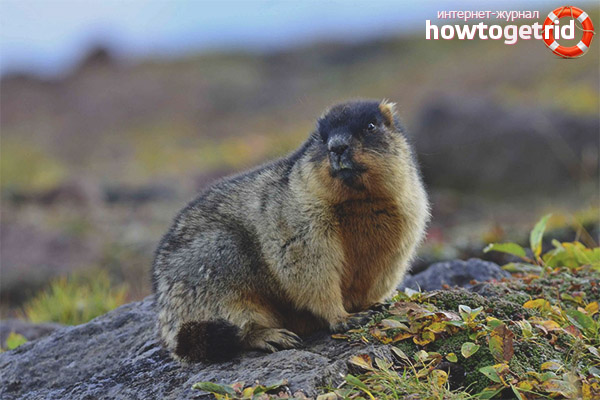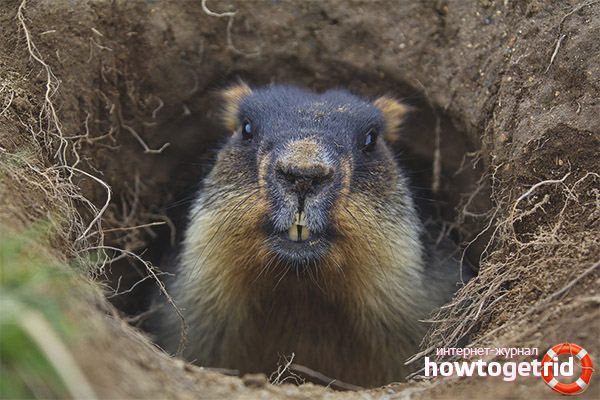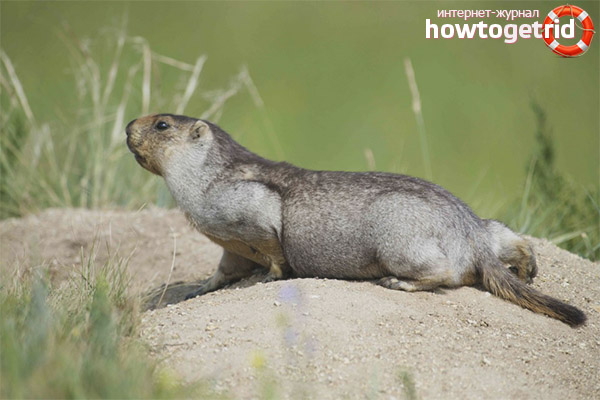The content of the article
Our open spaces are full of small and huge animals. But rodents, especially Mongolian tarbagans, do not play a secondary role.
The visual characteristics of the tarbagans
This animal belongs to the class of marmots. His body is quite large and weighty. The size varies from 55 to 63 centimeters, males are 5 centimeters larger than females.
These little animals weigh 4-8 kilograms. The head resembles a rabbit, its size is average. Marmots eyes are quite dark in color, nose is also gloomy. The neck is not long, but the olfactory and visual abilities are at a high level.
The paws are small, but the tail is long and about one third the size of the entire body. Mongolian rodents also have vivid and strong claws. The teeth are long like those of rabbits and beavers, the fur coat has a beauty and is usually either sandy or brownish in color. It is known that the color of a fur coat is much lighter after winter than before winter.
The fur of animals is endowed with increased fineness and density. It has an average length and quite soft to the touch. The paws have red hair, and at the end of the tail and head there is dark. Ears look like a circle, however, the same tendency is noticeable in red legs.
The most miniature species is the Talas Tarbagan, it has reddish fur with lighted spots on the sides. In general, the color of these "squirrels" depends on the region in which they live. There are gray, and yellow, and red, and darkish individuals. The color of the animals is focused on location features, it protects rodents from many dangerous enemies.
Locations of Tarbagans
The center and East of Kyrgyzstan, as well as Altai, were filled with a special Altai tarbagan. And the Yakut marmots were chosen by the southern and eastern parts of Yakutia, as well as the western territories of Transbaikalia and the north of the Far East.
A Talas marmot is located on the mountainous terrain of the Tien Shan, a black-caped rodent lives in Kamchatka, it is also called a tarbagan. Well, the Ferghana Tarbagan, who settled in Asia, completes the exposition.
It is easiest to meet Tarbagans in meadows, in the steppes, in forest-steppe regions, in foothills and near river basins. They like to live at 500-3000 meters above sea level.
Life features
Marmots prefer collective life. Despite the colony, there is a hierarchical layer in the form of a family. Each rodent family has its own mink, including nests, winter shelters, summer shelters, catacombs with a couple of exits and other underground dens designed for a specific purpose.
Tarbagans create many shelters, because due to their low speed they can not escape from a nimble predator. Their burrows are in depth from about 3 to 5 meters, and the length of the moves is 20 - 50 meters.
The family is a company of tarbagans with family ties. Each family is part of a particular colony, so there can be several families in one colony. The family composition consists of parents and children under the age of 2 years.
The settlement lives in harmony, but strangers within the family are not welcomed, and even driven out. In one colony there are about 15 - 20 marmots, but this is when there is a crop. In hungry years, the number of settlements can be reduced to a couple of rodents.
Small animals prefer to run during the daytime; usually, their awakening starts from eight to nine in the morning and lasts until six to seven in the evening. The whole family is focused on survival, in the afternoon there is construction of new holes and food production, but not everyone is doing it, someone is on guard and warns their relatives when a threat occurs. A noticeable whistle is given as an alarm, it then saves these animals from predators.
In general, these rodents are even anxious in case of safety. They can not go out of the hole for a long time, sniff and look, and only after a full understanding of what is happening leave their underground residence.
Hibernation and nutrition
With the onset of September autumn, hibernation occurs at the Tarbagans, they hide deep in burrows and sleep for 7 months. The colder the climate, the longer the hibernation lasts, and the warmer the less.
They block the entrance to the hole with waste products, grass and earth. They survive the cold winter due to overhanging snowdrifts and joint hibernation, when all the sleeping people unite in one place and heat each other, thereby maintaining their body temperature.
Nutrition after waking up begins in the spring, after which comes the summer molt, the process of reproduction and the accumulation of fat. Rodents feed on herbs, berries, roots. But they do not feed on crops for the reason that they do not populate the fields. When eating food, they try to sit and keep their food in their paws. In spring, there is not much grass, so the tarbagans feed on the roots and bulbs of various plant species.
In addition to plants, small insects, such as locusts, snails, crickets, ants, enter the stomach of animals. Tarbagans do not intend to eat insects, but on some days they make up one third of the food.
It would be worth thinking that tarbagans are mostly vegetarians, but growing them in reserves, you can make sure that they are very willing to absorb meat. Animals are able to gain up to a kilogram of body fat in one season under favorable conditions. They practically do not drink water, and more and more prefer to chew something.
Life cycle and breeding season
A month passes from the moment of hibernation, and the tarbagans begin the process of reproduction. Pregnancy of females lasts 5-7 weeks, and the number of "hatched" children varies from 4 to 6 individuals, but a little more happens. Newborns do not have fur; they are born blind and helpless enough. Only three weeks later, their eyes open.
Young rodents consume mother’s milk for one or two months, during the period of maternal feeding they gain a substantial 2 kilograms and grow up to 30-40 centimeters. A month passes and the newborns become interested in the world, they crawl out of the hole and begin to frolic like small children. The first hibernation of young animals takes place in the parent's estate, only a year later they acquire their own family.
Tarbagans live for about ten years in natural conditions, and under human supervision they manage to survive up to 20 years. People appreciate tarbagan fat, they say that it has a healing effect, it is especially good for skin restoration during burns and hypothermia.
Many hunters are interested in the fat, fur and meat of rodents, since there is a demand for it in society. As a result of a constant hunt for these animals, their population has seriously shaken. And now the tarbagans are on the verge of extinction, and even are listed in the Red Book of Russia.
Video: tarbagan (Marmota sibirica)













Submit